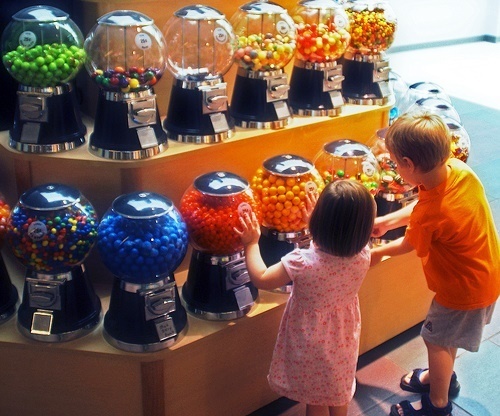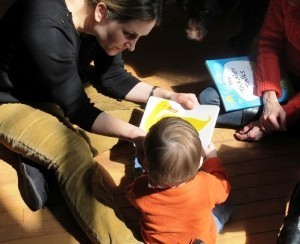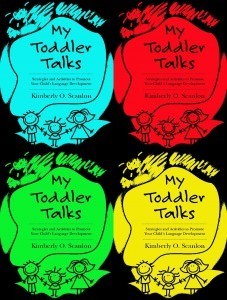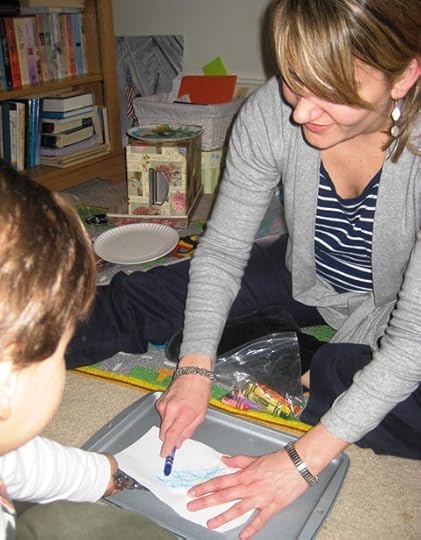Kimberly Scanlon's Blog, page 6
July 9, 2013
Speech Therapy for Toddlers: Give Choices
Speech Therapy for Toddlers: Give Choices
Photo Credit: pawpaw67
When we give choices to toddlers, we’re telling them that they have some control and their input matters. Providing choices also encourages decision making and promotes language development.
How do choices promote language development in toddlers?
When we provide choice questions, we are providing models of the potential target words for the child to imitate. For example, “Sammy, do you want the airplane or the truck?” The child hears the potential targets: “airplane” or “truck”. Open-ended questions like, “What do you want to play with?” can be harder because it’s requiring the child to recall and retrieve a word from memory.
Giving choices not only makes it easier for the child to potentially imitate and repeat, but it allows the child to point or gesture if he can’t say anything yet.
E.g. The child who points to the airplane is similar to an adult in a foreign country who doesn’t speak the language and orders his food by pointing to what the person at the next table is eating.
How can adults ask questions to promote language development in toddlers?
The adult can SAY the choices and SHOW the choices simultaneously. I highly recommend doing this if your child struggles to answer questions.
If the question is, “Sammy, do you want an airplane or truck?”, pick up the airplane with one hand (say it an show it) and pick up the truck with the opposite hand (say it and show it).
Depending on the child I like to give two choices at a time. Giving him 3 or 4 choices may get confusing. It all depends on the child.
With two choices, the adult can manipulate the choices to help the toddler make a decision and to help develop their language. Folks, this part is important. Read carefully.
Pair a preferred choice with a non-preferred choice. For example, you know your son hates green beans but loves peas or he prefers Buzz Lightyear over Woody. Pairing a preferred choice with a non-preferred choice makes it easier for the child to make a decision.
E.g., “Sammy, do you want to play with Woody or Buzz?”
To encourage imitation, put the preferred choice last. This is because the child will be more apt to remember the last thing you said making it more likely that he’ll imitate you.
E.g. “Sammy, do you want to eat green beans (non-preferred choice) or peas (preferred choice).
To encourage processing, put the preferred object first. This works very well for children who tend to echo or always repeat the last thing you said without thinking about it.
E.g. “Sammy, do you want to eat peas (preferred choice ) or green beans (non-preferred choice).
I hope you found these tips helpful!
How can you give choices during your daily routines or during play routines to help your toddler talk?
The post Speech Therapy for Toddlers: Give Choices appeared first on My Toddler Talks.
June 17, 2013
Speech Therapy for Toddlers: How to Ask Questions?
Speech Therapy for Toddlers: How to Ask Questions?
Adults like to ask questions. The well-known author of How To Win Friends and Influence People
 (a favorite book of mine), Dale Carnegie, teaches us to ask thoughtful questions to gain friends and effect people. Not only is it socially appropriate and nice to ask others questions, it also shows that we are genuinely interested in them. A pretty good way to treat others, if you ask me.
(a favorite book of mine), Dale Carnegie, teaches us to ask thoughtful questions to gain friends and effect people. Not only is it socially appropriate and nice to ask others questions, it also shows that we are genuinely interested in them. A pretty good way to treat others, if you ask me.
 by James Jordan
by James Jordan
Here’s a hypothetical – You go to a party where you don’t know a single soul. In attempts to meet new people and start up conversation, you ask questions. You meet a woman named, Stephanie. You ask: “So, Stephanie I see that you’re wearing those new TOMS shoes.” Are they comfortable? Everyone seems to be wearing them.” Well, before you know it, you’re having a lovely conversation about shoes and the latest fashion trends.
Does this technique of asking questions work for late talkers or language delayed children?
Well, it all depends on HOW you ask.
When I was a graduate student, finding the right balance on how to ask questions was terribly hard for me. I asked question after question in hopes that the little ones would start chit-chatting with me. “What’s your name?” “What did you do today?” And, if they didn’t answer or respond, I would ask even more questions! Usually, I followed up with a yes – no questions because I thought that if I changed it up, maybe they would respond.
“Did you have fun with Mommy at the Zoo?”
“Wanna play with the farm set?”
Sometimes, I find that striking the right balance when it comes to asking questions, is particularly challenging for parents.I see a lot of well-intentioned parents, beginning clinicians, and other professionals fall into, what I call, “tester mode”.
Tester mode is when we ask questions to test knowledge or to get a response.
For example: What’s this?” What does a cow say?” “Yesterday, we saw a cow. Do you remember Larry?” “Where did we go yesterday?” Then, the parent looks at me and says “He knows the answer, he’s just distracted.” So, they’ll get closer to him and give him more clues to answer the question. “Remember, we were feeding the cow and it licked your hand? Where did we go?” And, it continues.
Another problem with falling into “tester mode” is that different questions mean different things.
What vs. �Where vs. �Who vs. �Why� vs. When vs. �How are various types of open-ended questions with different degrees of difficulty. A child with a language delay may not know how to answer some of these questions. Check out Teaching Your Child How to Answer Questions, a very helpful article, by Communication Station to read more about it.
Now, imagine you’re at that cocktail party and you met someone and all they did was ask you question after question. “What’s your name? Where do you live? What do you do for a living?” “Come here a lot?” Hmmm…would you want to speak with this adult? Would you do this with another adult? Probably not. And, yet we do it with children.
It’s easy to fall into this habit and half the time we don’t even know that we’re doing it. Tester mode questions may initially get responses, but then interaction stops because it’s not fun for toddlers.
Here are some tips on how to ask questions to develop language in toddlers:
Replace the question with a comment.
When in doubt say something instead of asking something. Say, “I see Mickey Mouse”. Instead of picking up the stuffed animal and asking “Who is this?” Or, you could say, “I really like your picture” instead of asking “What is it?” “What did you draw?”
Pause.
Wait after saying your comment. Count 3 to 5 Mississippis. Children need time to process what you said. They need to think about how and if they are going to respond.
Still no response?
Make another comment. But, add something a little more. E.g. Mickey Mouse is my favorite.” “It looks like a ______”.
Balance questions with comments.
Generally, I like to say 3 comments and then ask a question. You’ll see I give a lot of examples of this in My Toddler Talks
I hope you have found this post helpful. 
Have you tried this technique with your own toddlers or clients? If so, how did it go? I would love to hear from you!
For more language tips and strategies, please see:
How to Use Self-Talk and Parallel-Talk
How to Use Books to Improve Your Toddler’s Language
The post Speech Therapy for Toddlers: How to Ask Questions? appeared first on My Toddler Talks.
June 8, 2013
Speech Therapy for Toddlers: How to Effectively Use Self-Talk and Parallel-Talk
Getting Your Toddler to Talk:
How to Effectively Use Self-Talk and Parallel Talk
You’re probably reading this post because you have concerns about your toddler’s speech and language development. If so, you’ve come to right site! Welcome to My Toddler Talks. I hope you find this site informative and helpful. I’m going to share two great techniques to help promote your toddler’s language development.
If you’re little guy is not yet talking, START your “intervention” by using:
Self-talk and Parallel talk
Self-talk is a speechie term. It simply means, talk about what you are doing, seeing, eating, touching, or thinking when your child is present. In other words, narrate your actions.
Some examples include:
“I’m washing the dishes. Now, I’m drying them. All done.”
“I see a doggie. He’s a big doggie. Jackson is a big doggie”.
“I’m cooking. I’m making mac and cheese. Yummy!”
Parallel talk is another speechie term and it’s the close brother to self-talk. To use parallel talk, talk about what your child is doing, seeing, eating, or touching. In other words, narrate what he is doing.
Some examples include:
“You’re building a big tower!” Wow!
“Uh oh, your tower fell down.”
“You’re cleaning up!”
“You threw the ball! Nice throw, Ben!
Okay, now hold it right there.
Before you even start thinking, “Oh, I already know this. I do this all the time.”
Allow me a few moments to give you the opportunity to really examine if you are using these techniques to their fullest potential.
Firstly, when using self-talk and parallel talk, you are not requiring your child to imitate what you are saying. Please do not have the expectation that your child is automatically going to repeat you. These techniques simply give your child exposure to language during play and daily routines. We’re using self-talk and parallel talk to expose the child to words and to make them realize that talking is fun AND functional. These techniques help to bridge the gap between a child who may not yet realize that objects, actions, and feelings, have names and they can be labeled and spoken about. If they imitate or repeat you, that’s wonderful, but it’s not expected at this point.
Self-talk and parallel talk should not be a play by play. If you’re getting winded (a very bad sign) or you notice that you’re doing all the talking, than you’re overdoing it.
Use words and phrases that are age appropriate. Some children may better understand if only one or two words are said (e.g. “washing dishes,” “drying dishes,” and “all done”), rather than longer phrases or sentences.
Most importantly – Do not use self-talk and parallel talk to divert their attention away from what they are interested in. If your child is earnestly looking at a pinwheel, a sticker, or whatever is striking his fancy – talk about THAT. Do not break his focus by turning away his attention to something that you are doing or saying. We’ve all done this before, but we have to remember that toddlers learn best when we follow their lead and interests. Janet Lansbury, over at Elevating Child Care, has a fantastic post where she shares 7 Ways to Build Your Child’s Focus and Attention Span. It’s worth checking out.
Here’s an example of how we may be tempted to break our child’s focus:
Benny is playing with his blocks and earnestly trying to stack them. He appears much focused on the task. You’re reading a magazine (as if! More like you’re scrambling to clean up the house, but this is a hypothetical here) and you see a cool picture of a train (one of Benny’s favorite things). Seeing this fantastic train picture makes you eager to use parallel talk (“Benny, I see a picture of a train!”). However, it also means that you would have to interrupt his play to tell him about the picture Hmmmm…what should you do?
In a case like this, I would probably use self talk once or twice to talk about his awesome block tower! I would wait to show him the train picture until there’s a natural break and when he switches gears to something else. Believe me perfect implementation is challenging. We are very prone to accidentally distracting babies and toddlers because we think what we have to say or show them is so important. I’m even guilty of doing this sometimes with my own 10 month old! However, if your child is concentrating on something, give him time to examine and explore it.
I hope this post has been helpful to you!
How can you use self-talk and parallel talk with you toddler? I would LOVE to hear from you!
The post Speech Therapy for Toddlers: How to Effectively Use Self-Talk and Parallel-Talk appeared first on My Toddler Talks.
May 31, 2013
How to Get the Most from My Toddler Talks!
How to Get the Most from My Toddler Talks!
If you’ve purchased my book (thank you), get the most out of it by following along and implementing some of these important points!
Incorporate a set playtime into the child’s daily routine.
Select a time when the child is well rested, fed, changed, and available for learning. This should also be an appropriate time for the adult; refrain from scheduling this time when one might be distracted by morning news shows, afternoon talk shows, evening sitcoms, or miscellaneous errands and chores. A thirty- to forty-five-minute period dedicated to playtime should suffice, depending on your schedule. If you have more time and your toddler wants to play longer, then by all means, continue to play! If you only have 15 to 20 minutes, that’s fine too. Just make sure to pick a time and go with it. Once a time has been selected, keep to this schedule, as routines are important to a child’s well-being. If you need help creating a schedule to organize your toddler’s daily routine, I included a section in My Toddler Talks dedicated to helping you develop routines for your toddler.
Follow the toddler’s lead during play.
Although My Toddler Talks provides fun activities with play routines included, it’s important to follow your child’s lead and allow him to make choices. The main goal should not be to complete an activity systematically, but rather to take turns and be responsive to his actions, sounds or words. Think of your toddler as a communicative partner. If you find that you are doing all the talking, then something is amiss. Focus on sharing and balancing the communication exchange. Do not become too focused on following every step in the routine. These directions are meant to be a helpful guide. Be flexible and allow the child to contribute and initiate.
Modify the play routines as needed.
You know your child best. I may be the expert when it comes to speech and language, but parents are the experts when it comes to their children. For this reason, my play routines can be easily adjusted to make them motivating for your toddler. If one routine seems too basic or too challenging, simplify a step, give more or less support, or skip it entirely and revisit that routine later. My play routines are not meant to be exhaustive, nor are they meant to be strictly interpreted. I only stress that you implement play routines that are somewhat repetitive and predictable. Following my instructions may make this goal easier to achieve. It will also allow the child to learn a certain concept and know what to expect.
Start and end with something easy, but challenge him a little in the middle.
Ohhhh, this is so important! Routines follow a sequence (I’ve mentioned this before). My play routines have a beginning, a middle, and an end. I like to start with something that is easy or very motivating for the child. Then, as time progresses (by the middle of the session), I challenge him with something new or different. As the session ends, I finish on a positive note by having the child participate in something that he is good at and has been successful doing. Be mindful to end a play routine BEFORE you sense that the child is losing interest. I also like to sing songs while cleaning up to make this a more enjoyable process. In my experience, most toddlers enjoy cleaning up and putting things away because they like to help and model adults! I share three of my favorite clean up songs in My Toddler Talks! But, you have to purchase my book to find them out!
Keep it simple and short.
For many activities, I’ve included sounds, words, or phrases to elicit speech and language from the child. Gauge what you think he can imitate or understand. Check out my post, When Will My Toddler Start Talking?, to learn a little bit about language development. For the child who is nonverbal or not yet talking, make sounds such as moo for a cow, choo choo for a train, or woof woof for a dog. For the child who is starting to imitate, say single words or very short and concrete phrases. If the child is only imitating one word when you say two or three, do not use five- or six-word sentences with the expectation that the child will repeat a targeted word; he will have already forgotten what you said!, In My Toddler Talks, I provide guidance in selecting potential target words. If you find that the child is not imitating anything you are saying or doing, then you must do some troubleshooting. I also include Troubleshooting Techniques, in My Toddler Talks, to assist you in getting your toddler to imitate you.
Set goals for your session.
I LOVE having goals and targets to keep me focused. Set goals for yourself and eventually, try devising some for your child.
Some sample goals for yourself can be:
“I will not try to overly control my child’s play, instead I will follow his lead and allow him to make choices.”
“I will not correct my child’s speech, instead I will provide praise for his attempts and causally repeat the target.”
Some sample goals for your child….are included in My Toddler Talks! I have an entire section devoted just to goals!
Chart your progress.
How can you know that you’re making progress with your toddler’s language? Establish a baseline by asking yourself, “What is my toddler doing now?” Then select goals, and track the specific changes or improvements related to your efforts. Taking these steps will help you stay motivated and know whether your efforts are effective. Once again, I have included a very helpful Progress Chart in My Toddler Talks to help you in this area.
Have fun!
Enjoy this special time with your child. Play allows for some quality bonding time that your child desperately needs and wants.
When toddlers are having fun, they want to learn.
Remember – praise the process, not just the result.
If you’ve enjoyed this post, I would be over the moon if you would share this post by clicking your preferred social media button(s) below! Also, please consider signing up for my free newsletter below. I share exclusive content, tips, and techniques with my subscribers.
Finally, I love hearing from you so please do tell me what you think in the comments section below. YOU are the reason why I devote so much time to perfecting my craft. Thank you!
The post How to Get the Most from My Toddler Talks! appeared first on My Toddler Talks.
April 4, 2013
When Do Toddlers Start Talking?
Setting Expectations: When Do Toddlers Start Talking?
One question, I’m usually asked is:
“When will my toddler start talking?”
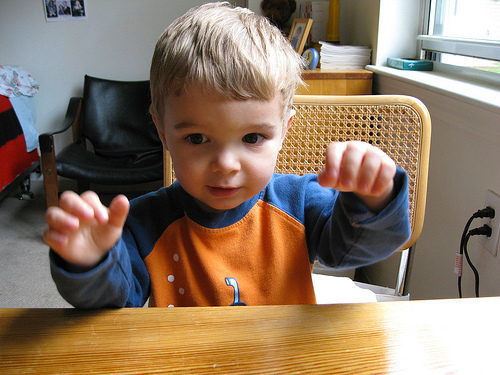
 by juhansonin
by juhansonin Answers to these questions are never easy because parents are stressed and naturally look forward to the day when their child can express his thoughts, his feelings, and his desires.
In most cases, this change doesn’t happen overnight. Yet, when parents are patient, motivated, and understand the natural progression of language development, they are more likely to notice and embrace the improvements.
“With love and patience, nothing is impossible.” Dr. Daisaku Ikeda
Typical language development usually happens in a somewhat predictable manner. However, please keep in mind that each child is unique and may deviate from the typical course of development.
Understanding words generally precedes saying words.
A language-delayed child or a late talker may first become responsive to communication before initiating dialogue. So, the toddler may follow directions (e.g., “Stop it” or “Come here”), identify pictures, or even use gestures or motions before saying words or verbalizing his intentions.
He may imitate before saying words or phrases on their own.
Toddlers often need to imitate and repeat spoken words and phrases before spontaneously applying them on their own. So don’t be shocked when you notice that your toddler is parroting everything you say. This happens even if he doesn’t understand the words you are using or what you are saying.
First words tend to be context bound.
What in the world does this mean? It means that toddlers may make a liar out of you! Say for instance, Patrick says “dog” for the first time when reading a favorite book. You are pretty excited so when your spouse comes home from work, you declare, “Patrick, can now say, “dog!”. So, you put Patrick to the test, and direct his attention to your dog, Tucker and say, “Patrick, what is Tucker?” Patrick is quiet and blankly stares at you. Besides this being a ridiculous question to ask a young child, it also shows that first words are rooted in certain contexts and situations. Toddlers understand a word based on its specific context. Eventually, the toddler’s understanding grows, and he learns to extend the word to multiple contexts and different situations. Eventually he’ll understand that the dog in the book and your pet Tucker are both dogs. Additionally, a word is a symbol that represents something on its own. A dog barking, a baby crying, or a cat meowing may convey meaning, but these sounds are not symbols, and therefore they are not words.
Sentences don’t occur overnight.
Lastly, it’s not realistic to assume that a child who has not been speaking will start saying phrases or sentences overnight. This can happen, but it is rare. Typically, children need to have a certain number of words in their repertoire before they can start combining words into phrases and sentences. A general rule of thumb is that children have fifty words in their repertoire before combining words. This is because when they get to this fifty-word benchmark, many children then usually have a “word spurt,” and their talking takes off. However, word spurts may not occur with all children. Some children’s language development may follow a more linear pattern, and their vocabulary may grow at a more constant rate regardless of how many words they have in their repertoire.
I hope this post helps not only to gauge your expectations, but also assists in noticing those improvements in your child’s development.
“Rivers know this: There is no hurry. We shall get there.” – A.A. Milne
If you’ve enjoyed this post I would be thrilled if you would share this post by clicking your preferred social media button(s) below! Also, please consider signing up for my free newsletter below.
Finally, I love hearing from you so please do tell me what you think in the comments section below. YOU are the reason why I devote so much time to perfecting my craft. Thank you!
The post When Do Toddlers Start Talking? appeared first on My Toddler Talks.
March 27, 2013
Toddlers: The Importance of Routines
Toddlers: The Importance of Routines
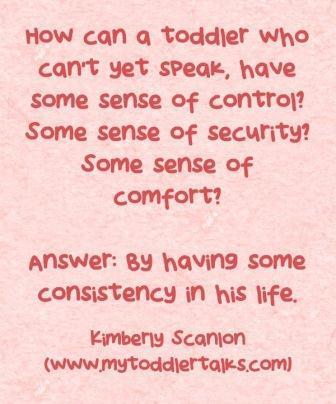
Routines and Toddlers
Do you have a morning routine?
I do. Having a morning routine keeps my sanity and increases my efficiency. When I know what I’m going to do in the morning (make a big ol’ pot of coffee), I feel somewhat in control and focused about how I go about my day.
When our routines are violated or drastically altered (e.g. the coffee pot breaks or we run out of coffee), how do we feel? Anxious, angry, aggravated…helpless.
Imagine being a toddler. Now imagine being a toddler who doesn’t yet have the words to express his feelings…his thoughts…his needs….his wants….Must be pretty frustrating.
How can a toddler who can’t yet speak, have some sense of control?
Some sense of security?
Some sense of comfort?
Answer: By having some consistency in his life.
Many toddlers like knowing what to expect because it gives them this sense of control, security and comfort.
Routines imply that there is some repetition and consistency.
Repetition and consistency are not boring to toddlers. In fact, many of them love it! Have you ever noticed that your child likes to read the same book over and over again? Or, that he likes to play with the same toy all the time? Or, that he has the same type of routine each time you read a book to him at nighttime (gets his teddy, rests his head on your shoulder, touches the page a certain way). He’s doing it because the routine helps him to relax and feel secure. Confidence grows from these feelings. Routines also help with discipline and compliance because he understands that if he wants to go to the park, he needs to change from his pajamas or clean up his mess.
How can routines help develop language?
By establishing routines, you help create a solid foundation in which to reduce distractions and conflicts. Since the toddler has some sense of control, security, and comfort from consistency, he can naturally focus and learn from his environment. His attention is not diverted from worrying about what happens next. For instance, he knows that after he eats breakfast, he brushes his teeth and then gets dressed.
When toddlers can anticipate what comes next, they are more likely to communicate and socially interact.
They can comment.
If Scottie knows he has to remove his shoes every time he comes home, it will be easier for him to eventually say, “Shoes off” because the concept is understood by his routine.
They can greet others.
If Rita’s mom always says “Hi” when she sees people, Rita will understand that greeting someone is a nice thing to do and will eventually wave, smile, and say “hi” to family and friends.
They can request.
If Max’s dad likes to say “Open sesame” each time he opens a door, Max will learn the meaning of open and soon realize that he needs to say open if he requires help opening a heavy door or twisting a sticky doorknob.
How can you help develop some predictable routines into your schedule?
Comments are welcome below!
If you have enjoyed reading My Toddler Talks, I would REALLY appreciate, if you could help spread the word about my book. Please tell your friends, write a kind review on Amazon, click the Facebook like button on the Amazon My Toddler Talks sales landing page. I would be thrilled to hear from my readers. YOU are the reason why I devote so much time to perfecting my craft. Thank you!
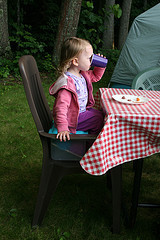
 by abbybatchelder
by abbybatchelder The post Toddlers: The Importance of Routines appeared first on My Toddler Talks.
March 17, 2013
Guest Post: My Toddler Talks Book Review
It gives me great pleasure to share the following review of My Toddler Talks by Dana Childress, M.Ed. Dana is a program specialist for the Virginia Early Intervention Professional Development, associated with Virginia Commonwealth University. She assists in designing and implementing professional development activities for early intervention providers and administrators in Virginia.
My Toddler Talks Review by Dana Childress, M.ED.

My Toddler Talks Book Review
If you are looking for a straightforward, easy-to-follow guidebook for parents on how to play with their toddlers in ways that support communication development, then this book should be on your list! My Toddler Talks is a very accessible and readable handbook that describes tips and play strategies that caregivers can easily implement in their daily interactions with their little ones. The book focuses on play routines, but the tips, modeling techniques and strategies can be incorporated into any daily interaction with a little practice. The tips and “do not list” are perfect for parents, childcare providers, and others who are looking for simple guidance on what they can do right now to positively affect a toddler’s language development.
My Toddler Talks offers tips for a variety of toy play routines and arts and crafts activities using common toys and materials. Each routines includes materials needed, a description of the routine, what to do at the beginning, middle, and end of the routine, and specific language techniques that parents can use during the routine. The simple descriptions would make it easy to try out these routines and the language techniques will help parents embed the author’s tips into the activity. The language used to describe each activity is familiar, engaging, and easy to understand.
I think this book would be a great resource for home visitors, childcare providers, preschool teachers, and early interventionists who are looking for practical ideas to share with families. There are lots of things that parents can do to enhance the language development of their children. This book makes it easy!
Dana Childress, M.Ed.
www.veipd.org/earlyintervention
Thank you so much, Dana!
If you have enjoyed reading My Toddler Talks, I would REALLY appreciate, if you could help spread the word about my book. Please tell your friends, write a kind review on Amazon, click the Facebook like button on landing page, or personally give me your feedback. I would be thrilled to hear from my readers. YOU are the reason why I devote so much time to perfecting my craft. Thank you!
The post Guest Post: My Toddler Talks Book Review appeared first on My Toddler Talks.
March 6, 2013
Toddlers: The Importance of Play
Toddlers: The Importance of Play
Playing and learning go hand in hand when it comes to toddlers. Play is how toddlers learn. Hands-on play is necessary for toddlers’ intellectual, social, emotional, physical and of course language development.
Playing develops cognition.
I love witnessing those moments when I see the lightbulb go on. Like when Sammy realizes that if he pushes a button something pops up…changes color… makes a sound. These problem solving skills are further developed when toddlers play. NOT when they watch TV, look at flashcards, or play on tablets. Witnessing these critical moments and watching a child’s eyes light up in wonder is a magical experience. My Toddler Talks has 25 different play routines to foster problem solving skills.
Playing enhances attention.
When a toddler engages in an enjoyable activity, he will attend to it. And, when he can attend to something, he will learn. Increase those attentive moments by letting your toddler pick an activity of his choice. My Toddler Talks will train you how to follow your toddler’s lead thereby increasing his attention.
Playing makes parents feel good!
As a working mother, I know it’s hard to make time to play with your child. However, when I sit down and play with my 7 month old baby girl, I feel good about myself. Having those quality moments, when I am fully present and not working, checking my emails, or reading text messages, makes me happy. My baby girl, Kerri is also happy to be getting mommy’s undivided attention. New studies show that playing reduces feelings of guilt and stress in parents. Remember the quality moments are so much more important than quantity. Quality play moments are memorable and encourage bonding between parent and child. When I was growing up, both my parents worked. However, they made time to play silly games. Did this play last for hours upon hours? No! If anything they lasted for a short amount of time, but they were quality and they were fun. That’s the most important thing to remember – make it quality – especially when you’re pressed for time.
Playing promotes language development.
I could write a book about how play helps develop language – oh wait, I already did! Play skills and language development tend to develop in parallel. For instance, when a child begins combining two words together, usually they also start using two toys together when playing. For instance, Bella begins playing with a toy phone by pretending to talk into it by herself. Then, as her language develops and word combinations emerge, her play becomes more sophisticated. She pretends that her toy doll is talking on the phone. Hence, she’s transferring the symbolism from herself to the doll. The doll is pretending to talk on the phone. Why is this so important? For several reasons (which I carefully explain in My Toddler Talks), but I’ll just mention a few thoughts here. First, we have to remember to play at our child’s appropriate cognitive level. If your child is only using a few words in limited contexts, then it’s not appropriate to engage him in long elaborate pretend play schemes (e.g. playing with a dollhouse vs playing with a shape sorter). Most likely, he will not really understand the complexity of this type of pretend play. Playing on his level is most beneficial. Secondly, when we are playing we can target getting a child to request help, to label and name different toys, to protest (they may already be good at this!), to greet others, to answer questions, to describe…the list goes on. All these communicative functions and more can be targeted in the comfortable and secure context of play!
How do you play with your toddler? How do you feel after a “play session”?
If you have enjoyed reading My Toddler Talks, I would REALLY appreciate, if you could help spread the word about my book. Please tell your friends, write a kind review on Amazon, click the Facebook like button on landing page, or personally give me your feedback. I would be thrilled to hear from my readers. YOU are the reason why I devote so much time to perfecting my craft. Thank you!
The post Toddlers: The Importance of Play appeared first on My Toddler Talks.
March 3, 2013
Why I Wrote My Toddler Talks
To help parents get their children talking! When I first began treating toddlers who were late to talk or delayed with their speech and language, I struggled to find easy to understand, step-by-step guides for my parents to read. Collecting information from various resources was trying and even then, I couldn’t find practical and hands-on resources. So, I decided to write a workbook for my parents!
My Toddler Talks is the culmination of several years of analysis of current research and work experience. I have completed all the play routines, performed all the techniques and strategies and continue to implement play routines and train current clients at my private practice Scanlon Speech Therapy, LLC.
If you have bought a copy of My Toddler Talks, thank you! I would love to hear what you think! Please email me your comments and feedback – kim@scanlonspeech.com
Thank you!
If you have enjoyed reading My Toddler Talks, I would REALLY appreciate, if you could help spread the word about my book. Please tell your friends, write a kind review on Amazon, click the Facebook like button on landing page, or personally give me your feedback. I would be thrilled to hear from my readers. YOU are the reason why I devote so much time to perfecting my craft. Thank you!
The post Why I Wrote My Toddler Talks appeared first on My Toddler Talks.
January 30, 2013
What is a Play Routine?
What is a Play Routine?

If you’ve already purchased my very helpful workbook, My Toddler Talks, give yourself a big pat on the back because you’ve been introduced to the amazing concept of a play routine. If you haven’t, what are you waiting for? Didn’t you read all the positive reviews and testimonials…? 
My Toddler Talks offers the reader a wealth of easy to understand information, techniques, tracking charts, goals as well as 25 entertaining play routines.
So, what is a play routine?
How are play routines different from play activities?
How do play routines facilitate language development in children?
A play routine is a purposeful way of playing and interacting with a child that follows a simple sequence. It involves predictability, repetition, and of course, lots of fun! Many toddlers like knowing what to expect because it gives them a sense of comfort, security, and control. When toddlers can anticipate what comes next, they are more likely to socially interact and communicate.
Having a routine implies that there is some repetition. Repetition allows for practice and multiple opportunities to acquire a new skill. Just like when we are learning something new (like playing the piano) we have to continually practice in order to do better; children who are not talking need that same preparation. Also, repetition is not boring to toddlers. In fact, many of them love it! Have you ever noticed that your child likes to read the same book over and over again? Or, that he likes to play with the same toy all the time? With my play routines, I have combined the excitement of play and the repetition and order of a routine into one!
A play routine is similar to a play activity because they are fun and interactive and allow for bonding, creativity, stimulation, and problem solving. However, a play routine is different than a play activity. Play activities do not have to intentionally follow a predictable order. They are not necessarily designed to trigger something to happen. A play routine, unlike a play activity, has been constructed to embed the learning through its actual structure.
In My Toddler Talks, I teach my reader how to elicit and model communication by participating in a play routine. Each of my 25 play routines has a beginning, a middle and an end. The beginning is marked by something that triggers the child to think, “We’re starting something new and exciting.” The middle is the real heart of the play and the longest part of the routine. This is also where I challenge the child a bit because he is most likely warmed up and fully engaged in the play. At the end, the child is alerted that the play is soon ending based on a predictable action, word, or song (e.g. Mommy is starting to sing the Clean Up song or Daddy is putting the baby doll to sleep). He has time to process that it’s time to clean up and get ready for the next event (e.g. picking his older brother up from school). It is in these play routines where I embed language learning techniques.
Too often adults try to target too many new things all at once. This is overwhelming for both the child and the adult. The beauty about play routines is that the learning is facilitated in an organized fashion. And, once you become familiar you can create your own play routines with your child!
How do you use play or routines to facilitate learning?
If you have enjoyed reading My Toddler Talks, I would REALLY appreciate, if you could help spread the word about my book. Please tell your friends, write a kind review on Amazon, click the Facebook like button on landing page, or personally give me your feedback. I would be thrilled to hear from my readers. YOU are the reason why I devote so much time to perfecting my craft. Thank you!
©2013 by Scanlon Speech Therapy, LLC. All rights reserved.
The post What is a Play Routine? appeared first on My Toddler Talks.

